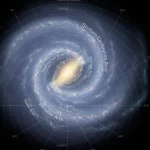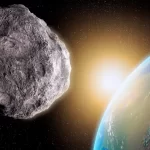Key Takeaways:
- A recent analysis of zircon crystals from the Apollo 17 mission indicates that the moon is at least 40 million years older than previously believed.
- The study focused on microscopic lunar rocks known as zircon crystals, revealing that they could be up to 4.46 billion years old.
- Earlier uncertainties in dating methods had led to a 2009 study setting the moon’s earliest possible birth date at around 4.42 billion years ago.
- The new study, published in Geochemical Perspectives Letters, confirmed the age of the crystals and provides a more accurate estimate of the moon’s formation.
- The moon’s age, based on this analysis, suggests it formed approximately 80 million years after Earth’s creation, challenging previous assumptions about the celestial body’s timeline.
A recent reevaluation of zircon crystals from the Apollo 17 mission has unveiled that the moon might be around 40 million years older than previously believed, challenging existing geological evidence. This revelation stems from a comprehensive study of tiny impact crystals found in lunar samples collected during NASA’s 1972 Apollo mission.
In 2021, scientists initially scrutinized these lunar gems, known as zircon crystals, to determine their age. Zircon crystals, microscopic rocks formed under extreme heat and pressure, are commonly used on Earth to date objects like impact craters. The analysis involved measuring the decay rate of uranium and lead isotopes in the crystals’ outer layers, indicating an age of up to 4.46 billion years.
However, the 2021 study acknowledged a significant level of uncertainty in the dating method, leading to the retention of the oldest confirmed lunar zircon crystals identified in a 2009 study. This previous analysis, part of a separate Apollo 17 sample, proposed the moon’s earliest birth date at approximately 4.42 billion years ago.
A recent study, featured in the journal Geochemical Perspectives Letters on October 23, reexamined the 2021 study’s crystals, focusing on the clustering of lead atoms within them. This reanalysis conclusively confirmed that the crystals are indeed around 4.46 billion years old.

Philipp Heck, a planetary scientist at the University of Chicago and the Field Museum’s research director, emphasized the significance of these crystals as the oldest known solids formed after the colossal Earth-Thea impact. He stated that their age serves as a crucial anchor for establishing the lunar chronology.
In comparison to Earth’s approximate age of 4.54 billion years, the zircon crystals formed around 80 million years after our planet’s creation. However, the collision leading to the moon’s formation could have occurred even earlier. Following the Earth-Thea crash, the moon’s surface likely featured a magma ocean, and the zircon crystals solidified only after this magma ocean had sufficiently cooled down.
A 2017 study attempted to estimate the duration of this magma cooling process based on data from multiple lunar zircon samples, suggesting a potential moon age of up to 4.51 billion years. However, Heck pointed out that this method was indirect, lacking direct age determination. Consequently, is considered the most accurate estimate of the moon’s age.

The evolving understanding of the moon’s history was highlighted in a 2017 revelation that the “man in the moon” is 200 million years older than previously thought. Furthermore, lunar samples collected by China’s Chang’e 5 rover in November 2022 indicated volcanic eruptions on the moon as recent as 2 billion years ago, challenging earlier assumptions.
In conclusion, the moon’s official birth date may undergo further revisions in the future, as ongoing research continues to unveil new insights into its geological evolution and history.


